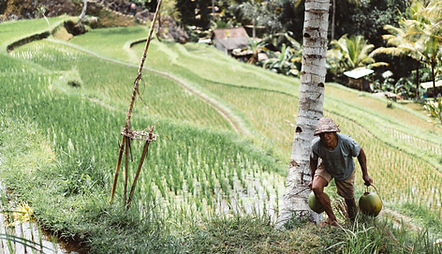
BIOGAS & ELECTRIC POWER FROM RICE STRAW WITH DIGESTATE TREATMENT AND MAP* PRECIPITATION
*Magnesium-Ammonium-Phosphate (MgNH4PO4)
Working principle of the newly developed fermentation process
The heart of the newly developed fermentation process is our Herbst-Loop-Reactor®, which essentially consists of a coupling between a mesophilic and a thermophilic fermenter.
In the first process step, the structure of the crushed rice straw is broken up bacterially within this Herbst-Loop-Reactor®. In the subsequent step, the cellulose and polysaccharides are converted into acetic acid. In the third process step, the acetic acid is converted into biogas by methanogenic bacteria.
The fermentation process is continuous, whereby the straw suspension within the two fermenters has a significantly different retention time. The fermentation process takes place at atmospheric pressure and at temperatures of < 70 ºC.
Depending on the plant configuration and the process design selected, different co-substrates such as pig or cattle manure or other liquid organic residues can be processed in conjunction with the rice or soya straw.
If, for example, cattle manure is used instead of process water for the production of the straw suspension, the biogas yield increases by approx. 20 % with the same fermenter volume.
In relation to the fresh mass (FM), the average specific biogas yield is > 350 Nm3 per tonne of rice or soya straw. The methane concentration in the biogas reaches values of > 60%.
The discharged digestate can easily be dewatered with conventional screw presses. After dewatering, the dry residue (DR) in the filter cake is approx. 20%. The structure of the filter cake can be compared with that of stable manure.
The dewatered digestate can be used as a high-quality organic fertilizer. The filtrate water is used as recyclate in the fermentation process to prepare the straw suspension. The newly developed fermentation process does not produce any liquid fermentation residues or other residues. Existing biogas plants can be retrofitted relatively easily to such an extent that process operation as with the Herbst-Loop-Reactor® is possible.
On the one hand, this plant extension achieves a significant increase in performance and, on the other hand, this process operation has the advantage that no more liquid fermentation residues are produced or have to be processed or disposed of.


Further digestate treatment
If the ammonium is to be separated from the filtrate water and the phosphate recovered, MAP precipitation to supplement the process is used. The pH value of the filtrate water is gradually changed in a stirred reactor and magnesium oxide (MgO) is added at the same time. Within a sedimentation reactor, the precipitated MAP crystals (MgNH4PO4) can be separated from the water phase.
With the help of our newly developed Herbst-Loop-Reactor®, rice straw can be fermented and thus converted into biogas, see Technical Description "Fermentation of rice straw into biogas".
The most important advantages of the Herbst-Loop-Process at a glance
-
Unused straw, which is a by-product, is fermented and converted into biogas.
-
The fermentation takes place at an atmospheric pressure and temperature of T˂ 70 ºC,
-
High specific biogas yield of > 350 Nm3 biogas/tonne straw based on fresh mass (FM),
-
Methane concentration in biogas > 60 %,
-
No liquid fermentation residues or other waste materials after the fermentation process.
-
Abscheidung von Ammonium und Rückgewinnung von Phosphor aus dem Filtratwasser bzw. Rezyklat.
-
Carbon dioxide neutral process for the production of electrical and thermal energy,
-
By using an absorption chiller, the unused waste heat can be converted into process cooling.
-
Durch den Einsatz einer Absorptionskälteanlage lässt sich die ungenutzte Abwärme in Prozesskälte umwandeln.
-
Optional recovery of mineral fertilizer.
-
Existing biogas plants can be retrofitted with regard to the performance increase and waste avoidance described above.

